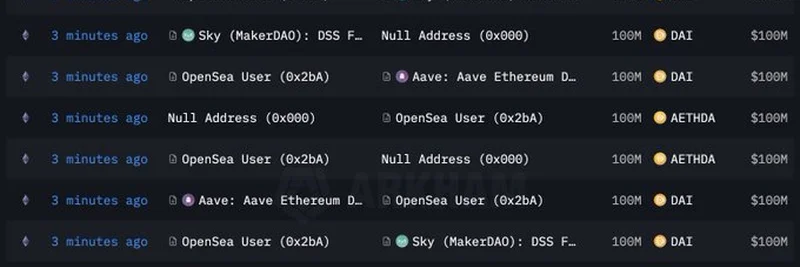Have you ever wondered what happens behind the scenes when massive crypto transactions occur? A recent tweet by MartyParty (@martypartymusic) on July 9, 2025, has sparked curiosity in the DeFi community. The post highlights a series of $100 million DAI transactions involving Aave, Sky (MakerDAO), and OpenSea users, hinting at something called "MEV behavior." Let’s break it down in a way that’s easy to understand, even if you’re new to the crypto world!
What’s Going On in the Tweet?
The image shared by MartyParty shows a transaction log with repeated $100M DAI transfers between null addresses (empty wallets), OpenSea users, Aave (a popular DeFi lending platform), and Sky (part of the MakerDAO ecosystem). These transactions happened almost simultaneously, raising eyebrows. MartyParty tagged @aave and @SkyEcosystem, asking, “What is this?”—and the crypto community is buzzing with theories.
What is MEV, Anyway?
MEV stands for Maximal Extractable Value, a term used in blockchain to describe the profit that can be made by manipulating the order of transactions. Think of it like a high-speed race where bots or traders jump ahead to take advantage of big trades. In this case, the $100M DAI clips might be linked to bots exploiting these large transactions for profit, a practice that’s both fascinating and controversial in the DeFi space.
For example, if someone moves $100M in DAI, a clever bot could "front-run" the trade—placing its own order first to buy DAI at a lower price, then selling it after the price spikes. This is legal (for now) but can leave regular users at a disadvantage.
The Players Involved
- Aave: A decentralized lending platform where users can borrow and lend crypto. It’s a key part of DeFi, and its involvement suggests these transactions might be tied to lending or collateral movements.
- Sky (MakerDAO): Part of the MakerDAO ecosystem, Sky is linked to DAI, a stablecoin pegged to the US dollar. The “DSS F..” in the log likely refers to a specific smart contract function, possibly related to debt settlement or liquidation.
- OpenSea: A major NFT marketplace. The presence of OpenSea users could indicate these funds are tied to NFT trades or wallet activities, though the exact connection isn’t clear yet.
- Null Addresses: These are empty wallets, often used as burn addresses or placeholders. Seeing them in $100M transactions is unusual and might hint at testing, exploits, or intentional fund movement.
Why Does This Matter?
This situation raises questions about transparency and security in DeFi. If MEV bots are indeed at play, it could mean regular users are losing out on profits or facing higher costs. The crypto community’s reactions—ranging from “very weird” to calls for answers from Aave and Sky—show how much this matters. Some, like @HillRobb, suggest bots are exploiting these large DAI trades, while others, like @0xOziii, expect silence from the platforms.
What Could Be Happening?
Here are a few possibilities:
- Bot Activity: MEV bots might be front-running or sandwiching these $100M trades, a common tactic on Ethereum where DAI is heavily used.
- Test Transactions: These could be simulated trades to test smart contracts or network upgrades, with null addresses acting as sinks.
- Exploitation Attempt: A more concerning idea is that someone might be probing the system for vulnerabilities, though there’s no evidence of a hack yet.
- Market Manipulation: Large, coordinated moves could be an attempt to influence DAI’s peg or market perception.
What’s Next for DeFi Enthusiasts?
For now, we’re waiting for official responses from Aave and Sky. If you’re into meme tokens or DeFi, this is a great moment to dive deeper into how blockchains work. Check out meme-insider.com for more updates on this story and other blockchain trends. Whether you’re a trader or just curious, understanding MEV and DeFi security can help you navigate the wild world of crypto smarter.
What do you think about this $100M mystery? Drop your thoughts in the comments, and let’s keep the conversation going!



